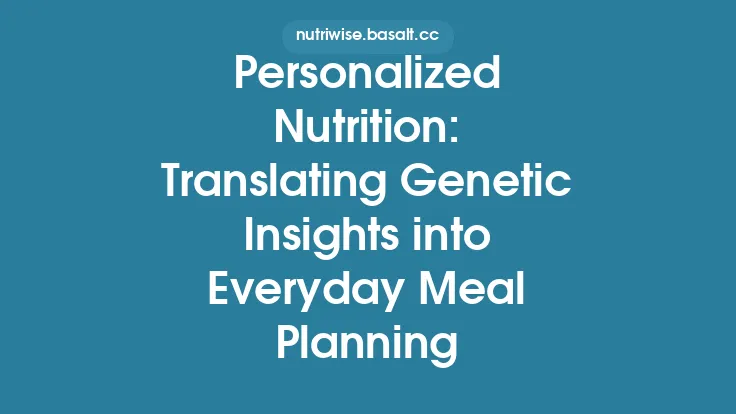Low‑carb and low‑fat diets have dominated the conversation around weight management and health for decades. While both approaches promise benefits such as weight loss, improved metabolic markers, and better overall well‑being, they rest on fundamentally different nutritional philosophies. Understanding how each works, the science behind their effects, and the practical considerations for everyday life can help you decide which—if either—fits your personal goals and lifestyle.
Foundations of the Two Approaches
What “Low‑Carb” Means
A low‑carbohydrate diet reduces the intake of foods that are high in sugars and starches—think bread, pasta, rice, potatoes, and many processed snacks. The exact definition varies, but most low‑carb plans aim for 20–130 g of net carbs per day (net carbs = total carbs – fiber). The reduction in carbohydrate availability forces the body to rely more heavily on fat oxidation and, in some cases, ketogenesis (the production of ketone bodies) for energy.
What “Low‑Fat” Means
A low‑fat diet limits the proportion of calories derived from fat, typically targeting ≤30 % of total daily calories from fat, with some stricter versions dropping below 20 %. This approach emphasizes lean proteins, whole grains, fruits, and vegetables, while discouraging high‑fat foods such as oils, butter, nuts, and fatty cuts of meat. The premise is that by reducing dietary fat—an energy‑dense macronutrient—overall caloric intake will decrease, facilitating weight loss and improving cardiovascular risk factors.
Metabolic Pathways: How the Body Responds
Energy Utilization
- Low‑Carb: When carbohydrate intake is limited, insulin secretion drops, prompting the liver to increase gluconeogenesis (making glucose from non‑carbohydrate sources) and to produce ketone bodies from fatty acids. Muscles and the brain can adapt to using these ketones, especially after several days of adaptation. Fat oxidation rates rise, and stored body fat becomes a primary fuel source.
- Low‑Fat: With abundant carbohydrates, insulin remains relatively higher, promoting glucose uptake and glycogen storage. Fat intake is limited, so the body relies more on dietary carbohydrates for immediate energy, while dietary fat is minimized. Excess calories, regardless of source, are still stored as adipose tissue, but the lower energy density of a low‑fat diet can make it easier to achieve a caloric deficit.
Hormonal Effects
| Hormone | Low‑Carb Impact | Low‑Fat Impact |
|---|---|---|
| Insulin | Decreases, reducing lipogenesis (fat storage) | Remains moderate; higher carb intake can cause modest spikes |
| Glucagon | Increases, stimulating hepatic glucose output and fat breakdown | Slightly elevated, but less pronounced |
| Leptin | May rise as fat mass decreases, improving satiety | May improve with weight loss, but satiety signals can be weaker if protein is low |
| Ghrelin | Often reduced after initial adaptation, aiding appetite control | May stay higher if protein intake is insufficient, potentially increasing hunger |
Evidence from Clinical Research
Weight Loss Outcomes
- Short‑Term (≤6 months): Meta‑analyses consistently show that low‑carb and low‑fat diets produce similar average weight loss when calories are matched. The difference often lies in adherence and individual response.
- Long‑Term (≥12 months): Studies indicate that adherence becomes the dominant factor. Participants who stick to either diet tend to lose more weight, regardless of macronutrient composition. Some long‑term trials report a modest advantage for low‑carb diets in preserving lean mass, likely due to higher protein intake.
Cardiovascular Markers
- Low‑Carb: Typically lowers triglycerides and raises HDL‑cholesterol. LDL‑cholesterol may increase in some individuals, but particle size often shifts toward larger, less atherogenic LDL particles.
- Low‑Fat: Often reduces total cholesterol and LDL‑cholesterol, especially when saturated fat is limited. HDL‑cholesterol may modestly decline, and triglycerides can stay unchanged or improve slightly.
Glycemic Control
- Low‑Carb: Improves fasting glucose, HbA1c, and insulin sensitivity, making it a common recommendation for individuals with pre‑diabetes or type 2 diabetes.
- Low‑Fat: Can also improve glycemic control if carbohydrate quality is high (whole grains, legumes) and total carbohydrate load is moderate. However, the effect is generally less pronounced than with low‑carb approaches.
Other Health Outcomes
- Blood Pressure: Both diets can lower systolic and diastolic pressure, largely through weight loss and reduced sodium intake (often a by‑product of processed‑food reduction).
- Inflammation: Low‑carb diets rich in omega‑3 fatty acids and antioxidants may reduce markers like CRP, while low‑fat diets emphasizing fruits, vegetables, and whole grains also show anti‑inflammatory benefits.
Practical Considerations for Everyday Nutrition
Food Choices and Meal Planning
| Aspect | Low‑Carb Tips | Low‑Fat Tips |
|---|---|---|
| Protein | Prioritize lean meats, fish, eggs, tofu, and low‑fat dairy; aim for 1.2–1.6 g/kg body weight. | Include lean protein sources; consider plant‑based proteins (beans, lentils) to keep fat low. |
| Carbohydrates | Choose non‑starchy vegetables, berries, nuts, and limited whole grains. | Emphasize whole grains, legumes, fruits, and starchy vegetables; watch portion sizes. |
| Fats | Use healthy fats (olive oil, avocado, nuts) but keep total fat moderate; avoid trans fats. | Limit added oils, butter, high‑fat dairy, and fatty cuts of meat; rely on cooking methods like steaming, baking, or grilling. |
| Snacks | Cheese sticks, nuts (in moderation), jerky, or veggie sticks with guacamole. | Air‑popped popcorn, fresh fruit, low‑fat yogurt, rice cakes with hummus. |
| Dining Out | Opt for grilled proteins, salads with vinaigrette on the side, and substitute fries with extra veggies. | Choose broth‑based soups, grilled fish or chicken, and request dressings/sauces on the side. |
Sustainability and Lifestyle Fit
- Social Settings: Low‑fat diets often blend more seamlessly into typical restaurant menus, whereas low‑carb may require more specific requests (e.g., “no bread” or “extra vegetables”). However, the growing popularity of low‑carb options means many establishments now offer keto‑friendly dishes.
- Cooking Skills: Low‑fat cooking emphasizes techniques that reduce added fats (steaming, poaching). Low‑carb cooking often involves higher protein preparation and creative vegetable substitutes (cauliflower rice, zucchini noodles).
- Budget: Low‑fat diets can be cost‑effective when centered around beans, lentils, and seasonal produce. Low‑carb diets may increase grocery bills if they rely heavily on meat, seafood, and specialty low‑carb products.
Potential Pitfalls
- Nutrient Gaps: Low‑carb diets may lack fiber, certain B‑vitamins, and electrolytes if not carefully planned. Incorporating plenty of non‑starchy vegetables, nuts, and seeds mitigates this. Low‑fat diets can be low in essential fatty acids (omega‑3) and fat‑soluble vitamins (A, D, E, K); adding modest amounts of fatty fish, nuts, or a quality supplement can help.
- Over‑Restriction: Both approaches can become overly restrictive, leading to binge cycles or nutrient deficiencies. Flexibility—such as “carb‑cycling” for low‑carb or “fat‑cycling” for low‑fat—can improve long‑term adherence.
- Misinterpretation of “Low‑Fat”: Not all fats are equal. Replacing saturated fats with refined carbohydrates can worsen metabolic health. Focus on quality over quantity: prioritize unsaturated fats while limiting trans and excess saturated fats.
How to Choose the Right Approach for You
- Identify Your Primary Goal
- *Weight loss*: Both can work; choose the one you can sustain.
- *Blood sugar control*: Low‑carb often yields faster improvements.
- *Cardiovascular health*: Low‑fat may be preferable if LDL‑cholesterol is a concern, but a low‑carb diet rich in unsaturated fats can also be heart‑healthy.
- Assess Your Lifestyle
- Do you enjoy cooking from scratch? Low‑carb may require more protein‑centric meals.
- Are you frequently eating out or traveling? Low‑fat options are often more readily available.
- Consider Personal Preferences and Tolerances
- Some people feel more satiated on higher‑protein, lower‑carb meals, while others thrive on carbohydrate‑rich, low‑fat plates.
- Digestive comfort: Very low‑carb diets can cause constipation if fiber is insufficient; low‑fat diets may cause cravings for richer foods.
- Trial Period
- Implement a 4‑ to 6‑week trial of the chosen approach, tracking weight, energy levels, hunger, and any biometric changes (e.g., blood pressure, fasting glucose).
- Adjust macronutrient ratios based on feedback—e.g., increase healthy fats if low‑carb meals feel too restrictive, or add a modest amount of quality fat if low‑fat meals leave you unsatisfied.
- Seek Professional Guidance
- A registered dietitian can help tailor macronutrient distribution, ensure micronutrient adequacy, and provide strategies for long‑term adherence.
Summary of Key Takeaways
- Mechanistic Differences: Low‑carb reduces insulin and shifts the body toward fat oxidation; low‑fat limits energy density and emphasizes carbohydrate‑driven metabolism.
- Health Impacts: Both can improve weight, blood pressure, and certain lipid profiles, but low‑carb tends to excel in triglyceride reduction and glycemic control, while low‑fat often lowers total and LDL cholesterol.
- Practicality: Low‑fat diets may be easier to follow in conventional eating environments, whereas low‑carb can be more satiating for some due to higher protein and fat content.
- Nutrient Balance: Regardless of the path, prioritize whole foods, adequate protein, fiber, and essential micronutrients. Avoid extreme restriction that could lead to deficiencies.
- Personalization is Paramount: The “best” diet is the one that aligns with your health goals, lifestyle, and personal preferences, and that you can maintain consistently over time.
By understanding the scientific underpinnings, weighing the pros and cons, and tailoring the approach to your unique circumstances, you can make an informed decision between low‑carb and low‑fat strategies—empowering you to achieve sustainable, everyday nutrition that supports both short‑term goals and long‑term health.





